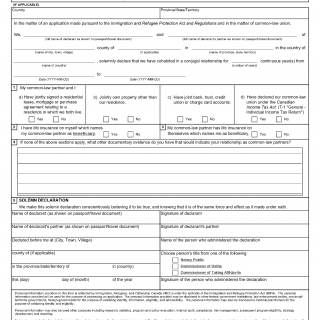Form IMM 5409. Statutory Declaration of Common-Law Union
The IMM 5409 is a Statutory Declaration of Common-Law Union form used by Canadian citizens or permanent residents who are in a common-law relationship with a foreign national. The main purpose of this form is to prove the existence of a common-law relationship between two individuals, which is a requirement for the foreign national to be eligible for immigration to Canada.
The form consists of two parts: the first part is the declaration of the Canadian citizen or permanent resident, and the second part is the declaration of the foreign national. Important fields on the form include personal information such as full name, date of birth, and address, as well as details about the common-law relationship such as the date it began, living arrangements, and financial support.
The parties involved in this form are the Canadian citizen or permanent resident and their partner who is a foreign national. It is important to consider providing as much detail as possible when completing the form, as it will be used to determine the eligibility of the foreign national for immigration to Canada.
When writing the form, the Canadian citizen or permanent resident will need to provide personal information about themselves and their partner, as well as details about their common-law relationship. In addition to the form, supporting documents such as proof of joint financial responsibility, joint ownership of assets, and shared living arrangements may also be required.
Application examples and use cases for this form include situations where a Canadian citizen or permanent resident is in a common-law relationship with a foreign national who wishes to immigrate to Canada. The form is necessary to prove the existence of the relationship and the eligibility of the foreign national for immigration.
Strengths of this form include its ability to provide a clear and concise way to prove the existence of a common-law relationship, which is necessary for immigration purposes. Weaknesses may include the potential for errors or omissions when completing the form, which could delay the immigration process.
Alternative forms or analogues to the IMM 5409 include the Affidavit of Common-Law Union, which is a similar form used for the same purpose. The main difference between the two forms is the format and wording used.
The form affects the future of the participants by providing a way for the foreign national to be eligible for immigration to Canada and potentially become a permanent resident or citizen. The form is submitted to the Canadian government and is stored in their records for future reference.
In conclusion, the IMM 5409 is an important form for Canadian citizens or permanent residents who are in a common-law relationship with a foreign national and wish to sponsor their partner for immigration to Canada. The form provides a clear and concise way to prove the existence of the relationship and is necessary for the foreign national to be eligible for immigration.

